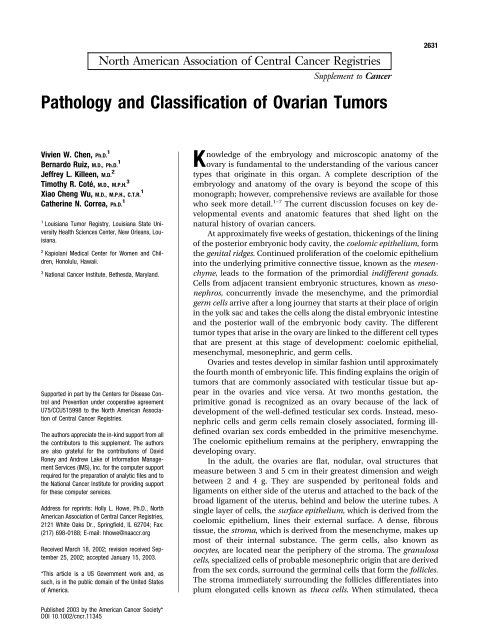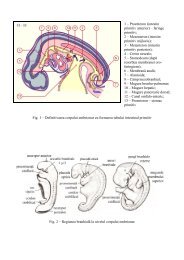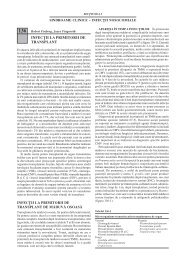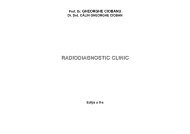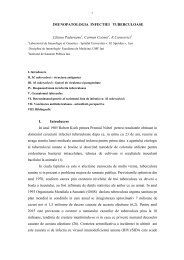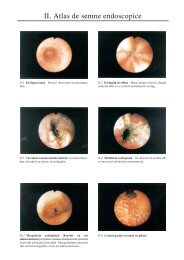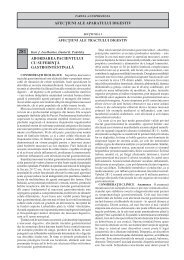Pathology and Classification of Ovarian Tumors - Cursuri Medicina
Pathology and Classification of Ovarian Tumors - Cursuri Medicina
Pathology and Classification of Ovarian Tumors - Cursuri Medicina
Create successful ePaper yourself
Turn your PDF publications into a flip-book with our unique Google optimized e-Paper software.
2638 CANCER Supplement May 15, 2003 / Volume 97 / Number 10tive years. In most cases, surgical excision is curative.Rupture <strong>of</strong> the tumor may result in peritoneal implants.In rare cases, mature cystic teratomas may undergomalignant transformation, most <strong>of</strong>ten in postmenopausalpatients, that most commonly results insquamous cell carcinoma. Other malignant tumortypes, including carcinoid, thyroid carcinoma, basalcell carcinoma, intestinal adenocarcinoma, melanoma,leiomyosarcoma, <strong>and</strong> chondrosarcoma, may arise.Prognosis is generally unfavorable; reported 5-yearsurvival rate are only 15–31%. Better prognosis is observedif the malignant component is squamous cellcarcinoma <strong>and</strong> if the tumor is confined to the ovary.Immature teratomas contain primitive, immature,or embryonal structures in addition to well-developedor mature tissues. These tumors usually are unilateral,large, <strong>and</strong> predominantly solid. Immature cystic teratomasare rare <strong>and</strong> most frequently occur in the firsttwo decades <strong>of</strong> life. Immature teratomas exhibit malignantbehavior, grow rapidly, spread by implantationthroughout the peritoneal cavity, <strong>and</strong> metastasize primarilythrough the lymphatic system. Excision usuallyis followed by local recurrence, but combination chemotherapy<strong>of</strong>ten leads to permanent remission.CLASSIFICATION OF OVARIAN TUMORSThe primary purpose <strong>of</strong> a tumor classification systemis to provide a st<strong>and</strong>ardized, reproducible communicationtool that reflects the variations in the naturalhistory <strong>of</strong> the disease <strong>and</strong> can be readily used byeveryone involved in the management <strong>of</strong> cancer. Development<strong>of</strong> such a system for ovarian tumors is awork in progress. In the past, a number <strong>of</strong> approacheswere advanced, but all fell short <strong>of</strong> the stated goal.Some systems were purely clinical, based on the hormonaleffects <strong>of</strong> ovarian tumors; however, differentovarian tumors may give rise to similar hormonal effects,similar tumors may have different hormonaleffects, <strong>and</strong> hormonal products may be derived insome cases from nonneoplastic (e.g., stromal) sourcesrather than from the tumor itself. Systems based onthe gross appearance <strong>of</strong> the tumors (solid or cystic)also were inadequate. A classification system based ontumor histogenesis would be a logical alternative, althoughthe histogenesis <strong>of</strong> some ovarian tumors iscontroversial.A significant stride in the direction <strong>of</strong> a histogenesis-basedclassification system was made in 1973with the publication <strong>of</strong> the World Health Organization(WHO) <strong>Classification</strong> <strong>of</strong> <strong>Ovarian</strong> <strong>Tumors</strong>. 14 This classificationsystem was updated in 1999 10 <strong>and</strong> was approvedby the International Society <strong>of</strong> GynecologicalPathologists (Table 1). A summarized version <strong>of</strong> theTABLE 1WHO Histologic <strong>Classification</strong> <strong>of</strong> <strong>Ovarian</strong> <strong>Tumors</strong> a1 Surface epithelial-stromal tumors1.1 Serous tumors: benign, borderline, malignant1.2 Mucinous tumors, endocervical-like <strong>and</strong> intestinal-type: benign, borderline,malignant1.3 Endometrioid tumors: benign, borderline, malignant, epithelial-stromal <strong>and</strong>stromal1.4 Clear cell tumors: benign, borderline, malignant1.5 Transitional cell tumors: Brenner tumor, Brenner tumor <strong>of</strong> borderlinemalignancy, malignant Brenner tumor, transitional cell carcinoma (non-Brenner type)1.6 Squamous cell tumors1.7 Mixed epithelial tumors (specify components): benign, borderline, malignant1.8 Undifferentiated carcinoma2 Sex cord-stromal tumors2.1 Granulosa-stromal cell tumors: granulosa cell tumors, thecoma-fibromagroup2.2 Sertoli-stromal cell tumors, <strong>and</strong>roblastomas: well-differentiated, Sertoli-Leydigcell tumor <strong>of</strong> intermediate differentiation, Sertoli-Leydig cell tumor poorlydifferentiated (sarcomatoid), retiform2.3 Sex cord tumor with annular tubules2.4 Gyn<strong>and</strong>roblastoma2.5 Unclassified2.6 Steroid (lipid) cell tumors: stromal luteoma, Leydig cell tumor, unclassified3 Germ cell tumors3.1 Dysgerminoma: variant-with syncytiotrophoblast cells3.2 Yolk sac tumors (endodermal sinus tumors): polyvesicular vitelline tumor,hepatoid, gl<strong>and</strong>ular3.3 Embryonal carcinoma3.4 Polyembryoma3.5 Choriocarcinoma3.6 Teratomas: immature, mature, monodermal, mixed germ cell4 Gonadoblastoma5 Germ cell sex cord-stromal tumor <strong>of</strong> nongonadoblastoma type6 <strong>Tumors</strong> <strong>of</strong> rete ovarii7 Mesothelial tumors8 <strong>Tumors</strong> <strong>of</strong> uncertain origin <strong>and</strong> miscellaneous tumors9 Gestational trophoblastic diseases10 S<strong>of</strong>t tissue tumors not specific to ovary11 Malignant lymphomas, leukemias, <strong>and</strong> plasmacytomas12 Unclassified tumors13 Secondary (metastatic) tumors14 Tumorlike lesionsWHO: World Health Organization.a Source: Scully R, Sobin L. Histological typing <strong>of</strong> ovarian tumours, volume 9. New York: Springer Berlin,1999. 10WHO classification system was proposed in 1998 bythe International Agency for Research on Cancer 15 foruse in comparative studies; this system was used toclassify histologic types <strong>of</strong> ovarian cancer in the currentmonograph (Table 2). Two coding systems, theWHO International <strong>Classification</strong> <strong>of</strong> Diseases for Oncology16 <strong>and</strong> the College <strong>of</strong> American Pathologists SystematizedNomenclature <strong>of</strong> Medicine, 17 are commonlyused to code the histology/morphology <strong>of</strong>tumors.
<strong>Ovarian</strong> Tumor <strong>Pathology</strong> <strong>and</strong> <strong>Classification</strong>/Chen et al. 2639TABLE 2IARC Histologic Groups <strong>of</strong> <strong>Ovarian</strong> <strong>Tumors</strong> aHistologic typeWHO ICD-O morphology code1. Carcinoma 8010–8570, b 9014–9015, 91101.1 Serous carcinoma c 8441–8462, 90141.2 Mucinous carcinoma c 8470–8490, 90151.3 Endometrioid carcinoma 8380–8381, 8560, 85701.4 Clear cell carcinoma 8310–8313, 91101.5 Adenocarcinoma NOS 8140–8190, 8211–8231, 8260, 84401.6 Other specified carcinomas1.7 Unspecified carcinoma 8010–80342. Sex cord-stromal tumors 8590–86713. Germ cell tumors 8240–8245, 9060–91024. Other specified cancers (includingmalignant Brenner tumor,müllerian mixed tumor, <strong>and</strong>carcinosarcoma)5. Unspecified cancer 8000–8004IARC: International Agency for Research on Cancer; WHO: World Health Organization; ICD-O: International<strong>Classification</strong> <strong>of</strong> Diseases for Oncology; NOS: not otherwise specified.a Source: Parkin DM, Shanmugaratnam K, Sobin L, Ferlay J, Whelan SL. Histological groups forcomparative studies, volume 31. IARC technical report. Lyon: International Agency for Research onCancer, 1998. 15b Excludes 8240 – 8245.c Includes tumors <strong>of</strong> borderline malignancy (low malignant potential). Unlike borderline tumors <strong>of</strong>other types, borderline tumors <strong>of</strong> serous <strong>and</strong> mucinous types are included with carcinomas by ICD-O.This approach remains to be validated fully.STAGING OF OVARIAN CANCERThe extent <strong>of</strong> tumoral spread, also known as stage <strong>of</strong>disease, at diagnosis is typically established by radiologicevaluation <strong>and</strong> surgical excision. Surgical managementmay include debulking <strong>of</strong> the tumor resection<strong>of</strong> one or both ovaries, fallopian tubes, <strong>and</strong>uterus, as well as sampling <strong>of</strong> lymph nodes, liver, <strong>and</strong>suspicious sites within the abdomen. Staging <strong>of</strong> ovariansurface epithelial-stromal tumors is performed accordingto the TNM system, 18 the set <strong>of</strong> guidelinesestablished by the American Joint Committee on Cancer,which is comparable to an alternative stagingsystem approved by the International Federation <strong>of</strong>Gynecology <strong>and</strong> Obstetrics (FIGO) (Table 3). 19HISTOLOGIC GRADING AND PROGNOSTIC FACTORSMicroscopic examination is critical for predicting tumorbehavior <strong>and</strong> deciding the best therapeutic approach.Such examination includes the assessment <strong>of</strong>specific histologic type <strong>and</strong> extent <strong>of</strong> disease <strong>and</strong> thegrading <strong>of</strong> tumor differentiation (i.e., the extent towhich the tumor resembles the normal tissue). <strong>Tumors</strong>are graded as well-differentiated (G1), moderatelydifferentiated (G2), poorly differentiated (G3), orundifferentiated (G4). As discussed above, surface epithelial-stromaltumors also can be classified as borderlinemalignancy (GB). Attempts to identify prognosticallyrelevant pathologic features in ovariancancers are hindered by the diversity <strong>of</strong> tumors thatare encountered. Most reported prognostic informationaddresses surface epithelial-stromal tumors.The two most important prognostic factors forsurface epithelial-stromal tumors are tumor stage <strong>and</strong>the presence or absence <strong>of</strong> residual disease after treatmentintervention. 18 Specific histologic typing <strong>and</strong>grading may have prognostic significance as well;however, the independent contribution <strong>of</strong> each <strong>of</strong>these factors after adjusting for tumor stage has notbeen well established. Assessment <strong>of</strong> their contributionis hampered by interobserver variability amongpathologists, lack <strong>of</strong> st<strong>and</strong>ardization <strong>of</strong> gradingschemes, <strong>and</strong> differences in treatment among publishedseries. Most grading schemes analyze architectural<strong>and</strong> cellular characteristics <strong>of</strong> tumors <strong>and</strong> delineatethree or four groups with increasing risks <strong>of</strong>aggressive behavior. Unfortunately, it is difficult toapply a single grading system consistently to all histologictypes <strong>of</strong> ovarian cancer. Recently, modifiedgrading systems that can be applied to all epithelialovarian cancers have been proposed. 20,21 Early confirmatorystudies are encouraging, as they indicate thathistologic grading may finally establish itself as animportant prognostic factor for patients with ovariancarcinoma. 22The grading <strong>of</strong> sex cord-stromal tumors has beenfrustrating. This is not unexpected, given that the histogenesis<strong>of</strong> several subtypes still is unclear. For somesubtypes, definitive histologic criteria for making thedistinction between benign <strong>and</strong> malignant tumors arelacking. Histologic features that relate to the potentialfor aggressive behavior appear to be subtype-specific;for example, all granulosa cell tumors are consideredto have malignant potential. Attempts to grade thesetumors using nuclear characteristics or mitotic activitycounts have produced inconsistent results, whereastumor size <strong>and</strong> stage appear to be more reproducibleprognostic factors. Most stromal tumors are benign.The uncommon malignant variant, fibrosarcoma, isassociated with an aggressive clinical course, but itlacks an established grading system. The steroid celltumors (luteoma <strong>and</strong> Leydig cell tumor) also are difficultto classify as benign or malignant based onmicroscopic features alone. Pathologic features thatare reported to be correlated with malignant behaviorinclude large size, high mitotic rate, necrosis, hemorrhage,<strong>and</strong> prominent nuclear atypia. Other sex cordtumors (Sertoli cell tumor, Sertoli-Leydig cell tumor,sex cord tumor with annular tubules, <strong>and</strong> gyn<strong>and</strong>roblastoma)have varied clinical behaviors that showsome correlation with specific differentiation criteria
2640 CANCER Supplement May 15, 2003 / Volume 97 / Number 10TABLE 3<strong>Ovarian</strong> Surface Epithelial-Stromal Tumor Staging Protocols: AJCC TNM System a <strong>and</strong> FIGO Staging System bAJCC FIGO DescriptionTXPrimary tumor cannot be assessed.T0No evidence <strong>of</strong> primary tumor.T1 I Tumor limited to ovaries (one or both).T1a IA Tumor limited to one ovary; capsule intact, no tumor on ovarian surface. Nomalignant cells in ascites c or peritoneal washings.T1b IB Tumor limited to both ovaries; capsules intact, no tumor on ovarian surface. Nomalignant cells in ascites or peritoneal washings.T1c IC Tumor limited to one or both ovaries, with any <strong>of</strong> the following: capsule ruptured,tumor on ovarian surface, malignant cells in ascites or peritoneal washings.T2 II Tumor involves one or both ovaries with pelvic extension.T2a IIA Extension <strong>and</strong>/or implants on uterus <strong>and</strong>/or tube(s). No malignant cells in ascites orperitoneal washings.T2b IIB Extension to other pelvic tissues. No malignant cells in ascites or peritonealwashings.T2c IIC Pelvic extension (2a/IIA or 2b/IIB) with malignant cells in ascites or peritonealwashings.T3 <strong>and</strong>/or N1 III Tumor involves one or both ovaries, with microscopically confirmed peritonealmetastasis outside the pelvis <strong>and</strong>/or regional lymph node metastasis. dT3a IIIA Microscopic peritoneal metastasis beyond pelvis.T3b IIIB Macroscopic peritoneal metastasis (2 cm or less in greatest dimension) beyondpelvis.T3c <strong>and</strong>/or N1 IIIC Peritoneal metastasis (more than 2 cm in greatest dimension) beyond pelvis <strong>and</strong>/orregional lymph node metastasis.M1 IV Distant metastasis (excludes peritoneal metastasis). eAJCC: American Joint Committee on Cancer, FIGO: International federation <strong>of</strong> Gynecology <strong>and</strong> Obstetrics.a Source: Fleming ID, Cooper JS, Henson DE, Hutter RVP, Kennedy BJ. American Joint Committee on Cancer (AJCC) cancer staging manual. Philadelphia:Lippincott-Raven, 1997. 18b Source: Heintz AP, Odicino F, Maisonneuve P, et al. Carcinoma <strong>of</strong> the ovary. J Epidemiol Biostat. 2001;6:107–138. 19c Ascites is the accumulation <strong>of</strong> excessive fluid within the abdominal (peritoneal) cavity. The presence <strong>of</strong> nonmalignant ascites is not classified. The presence <strong>of</strong>ascites does not affect staging unless malignant cells are present.d Lymph nodes located in the pelvis or in the back <strong>of</strong> the abdomen on either side <strong>of</strong> the aorta (para-aortic). Liver metastases confined to the capsule are T3/StageIII. Liver parenchymal metastases are M1/Stage IV.e Pleural effusion must have positive cytology for M1/Stage IV malignancy.that are well defined in the gynecologic pathologyliterature. 8Stage <strong>of</strong> disease at diagnosis is the most importantprognostic factor for germ cell tumors. Determination<strong>of</strong> the specific histologic subtype has prognostic relevance,but grading within or across these categoriesgenerally is not performed. One exception is the immatureteratoma, for which histologic grading is basedon the amount <strong>of</strong> immature tissue (usually neuroectodermal)that is present. 11EXTRAOVARIAN PERITONEAL CARCINOMABeginning in the 1940s, several reports described theoccurrence <strong>of</strong> an apparent ovarian cancer in womenlong after removal <strong>of</strong> their ovaries. The cause washotly debated, but the microscopic resemblance <strong>of</strong> themalignancy to surface epithelial ovarian tumors (serous,mucinous, <strong>and</strong> endometrioid subtypes) wasstriking. Women with the disease experienced a clinicalcourse similar to that <strong>of</strong> women with primaryovarian cancer. Some investigators believed that thiswas a latent manifestation <strong>of</strong> metastatic ovarian cancerthat preceded removal <strong>of</strong> the ovaries. Otherspointed to malignant transformation <strong>of</strong> ectopic endometrialtissue (e.g., endometriosis) as the source <strong>of</strong>these cancers, while another hypothesis was that thecoelomic epithelium was shed throughout the peritoneumas it traveled along its migratory course throughthe embryonic female.Whatever the cause, it is clear that a small proportion( 5%) <strong>of</strong> cancers that microscopically appearto be ovarian actually do not originate in the ovary <strong>and</strong>instead arise from the peritoneum. The morphologicsubtypes <strong>of</strong> extraovarian peritoneal carcinomas(EOPC), now commonly referred to as primary peritonealcarcinomas (PPC), are limited to the more commonsubtypes <strong>of</strong> surface epithelial malignancies (serous,mucinous, <strong>and</strong> endometrioid), <strong>and</strong> the


